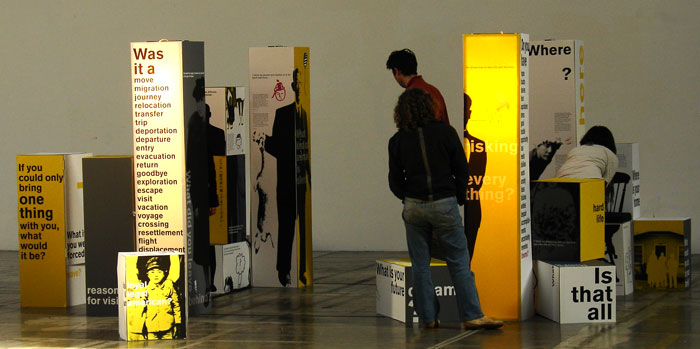SPACES TO DISCOVER NARRATIVE
Mark Meadow’s work looking at “systems for open-ended knowledge building”–from curiosity cabinets to Breugel’s Netherlandish Proverbs (1559) to 16th century notebooks–examines early 16th and 17th century models of knowledge building to inspire current ways of interpreting and processing information. He is interested in unconventional systems of presentation with which to read and understand images or objects. In the case of curiosity cabinets and memory theatre, the way that the content is displayed, arranged and juxtaposed allow the viewer to make new associations (and not necessarily along a linear path) that result in “activating the material” (6). These systems are full sensory collections that are experientially driven—a participant interacts with the material in order to arrive at an understanding of the content. The objects begin to speak to each other in this microcosm. Whether a piece of coral is considered an animal or a piece of mineral will depend on where it is positioned in the wunderkammer, as well as who is looking at it. Mark Meadow describes that this interaction is initiated by the “eye of the viewer that sets the process in motion” linking what they look at to their own personal experiences (7).
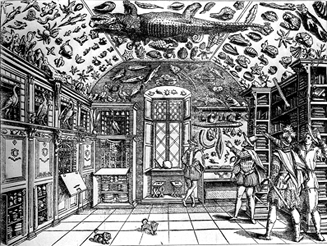
16th century wunderkammer
Here|there is inspired by the strategies of the curiosity cabinet. It was also driven by my interest in exhibition spaces that allow content to come off of the walls and be revealed through a range of interactions. It explores exhibitions as a medium both physically interactive and encompassing a variety of different sensory experiences to provide a rich, dimensional communication of story. However, exhibitions are not just containers for content, but are the structures and systems themselves that enable certain discoveries and explorations. Exhibition design, as architect Tim Durfee describes, gives content a “form language” which allows for a “quality of discovery that only happens in physical space.” Thus, the shape of the exhibition is determined by the shape of information (content) and the shape of experience (interaction) (8). The shape creates meaning.
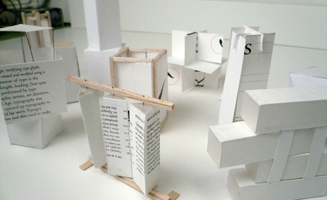
For example, in the here|there exhibition, the participants engagement in physical space results is a significant aspect of the design. The historic photos of my grandparents were taken out of their original context and represented as human-scale figures in the exhibition. Participants make a physical and emotional connection to the images by coming face to face with the subjects and walking amongst them. They humanize the content and offer more direct connections between the stories and the people involved. The different panels interact and shift meaning–they ask the participant to rethink and reconsider these relationships.

Discovery through interaction
“Perception replaces bare recognition. There is an act of reconstructive doing, and consciousness becomes fresh and alive.” –John Dewey (9)
Yoko Ono’s Cleaning Piece demonstrates how an individual action in a physical space can alter the experience in a public space. Ono’s instructions encourage participants to “Pick up the stones, identify them with a particular memory, and place them in small adjacent spaces–the happiness space, the sadness space” (10). The environment not only changes visually, but the energy of the participants interacting with the space creates another type of experience.
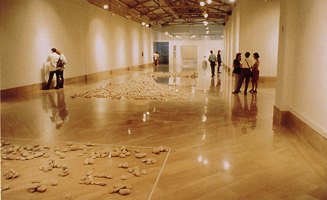
Here|there aligns itself with Ono’s piece. Guided by the concept of displacement, the structure of the exhibition emphasizes movement and pathways, such as passing through a gate between two pillars or crouching down to look into a tunnel. Panels can be moved to reveal and hide information and hint of something that was once there but then moved. Displacement is conveyed as sightlines shift, images fragment, footprints are left behind, text wraps around corners and images appear and disappear. These formal structures also result in the participant taking on various movements and positions in the space, much like a performance.
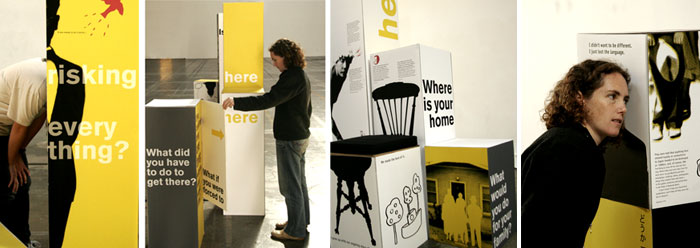
|
The four story gatherings are structured to communicate the interactions and concepts of the story themes (passages, dreams, home, identity) derived from the drawings. Home offers a porch-like seating space with which to access the audio. Identity is about looking inward—the stories are triggered by opening a door into someone’s head and looking inside. Dreams requires coming in close to hear secrets. In passages, one must move through two pillars to hear stories.
Earlier design research exercises such as the artifact workbooks looked at systems of presenting and reorganizing content in a more interactive way. They were inspired by the concept of the 15th c. notebook in which a collection of information, such as a list of proverbs, were organized by a wide range of topics, from language to symbols to colors, to allow new juxtapositions and associations to emerge and offer a new “read” of the material. In the workbooks, stories and images are printed, arranged, edited and re-printed to allow information to be added, subtracted, remixed and reorganized in a palimpsest-like manner.

Similarly the exhibition integrates concepts of modularity and remixing. The box structures are designed to communicate individually, as a thematic gathering, and together in the space as a whole unit. The participant becomes the remixer as roaming around the space reveals different landscapes and relationships. The audio illustrates this notion of remixing on different levels. It was composed by remixing layers of music that reflect each story gathering theme. Also as the participants move through the space, the narrated stories layer and combine. If more than one track is playing, the intentional pauses in the audio tracks allow for words and music to overlap, and creates an environment that evolves with each interaction.
This informed interaction puts the focus on the participant to arrive at an enlivened construction of the narrative. In his essay establishing the practice of productive interaction, Phil van Allen writes, “An alternative approach is to switch the audience from consumer to producer…encourage active meaning-making rather than passive consumption of experiences. In this way, users become responsible for their outcomes and conclusions and gain a deeper understanding of the communication.” (11) A greater sense of investment occurs on the part of the participant who is presented with the opportunity to discover and learn by their experience. The design of here|there seeks to draw upon the kinds of interactions that, “offer a similar system of personal discovery, but one that is more outward and expressive, using the direct experience of working with content to create a productive discovery within a media rich environment” (12).

One of the challenges of the case study was figuring out how interactions would be affected when several people share the space simultaneously. In here|there physically moving through the space and engaging in a range of interactions changes the environment for all involved. For example, light and audio are sensor-driven, triggered by interactions such as the participant moving up to a box or opening a panel. When one person occupies the space, the effects are much more in the hands of the participant, who can control his or her own experience. However, when multiple people are in the space, the interactive components are affected by the activities of various people at the same time. It becomes harder to know who is controlling the media. Moving, colliding, talking, and listening become different forms of group interactions. Not anticipating these kinds of outcomes, they created exciting tensions, added unexpected layers, and provided satisfying insights that could only emerge through the process of designing, building and testing these experiences.
